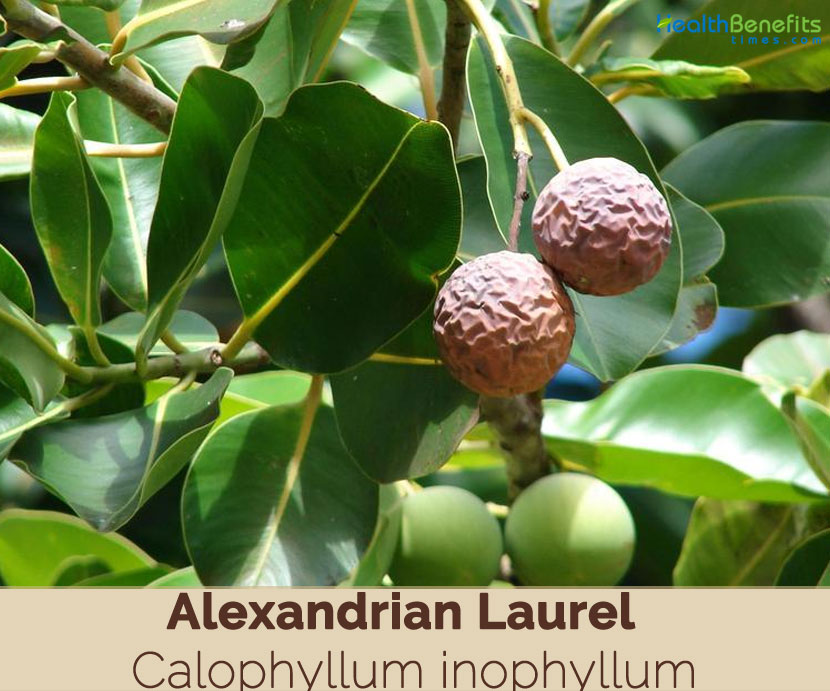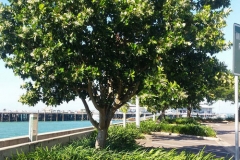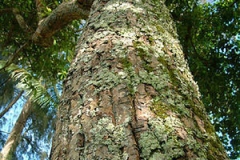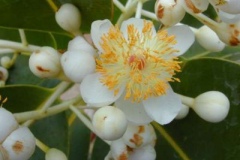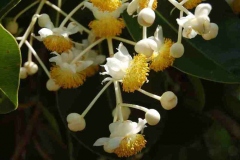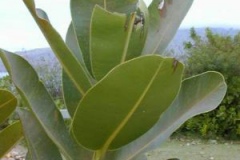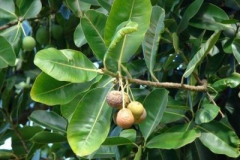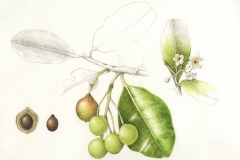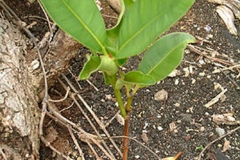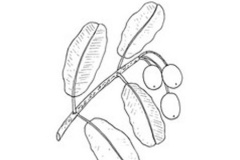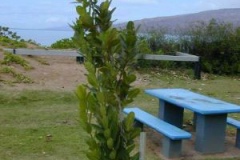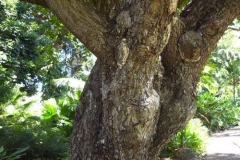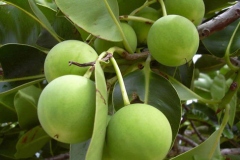| Alexandrian Laurel Quick Facts | |
|---|---|
| Name: | Alexandrian Laurel |
| Scientific Name: | Calophyllum inophyllum |
| Origin | Old world tropics from East Africa, southern coastal India to Malesia, northern Australia and the Pacific islands |
| Colors | At first pinkish-green later turning bright green and when ripe, it turns dark grey-brown and wrinkled |
| Shapes | Globose to sub globose drupe, 2.5–4 cm in diameter, found in clusters |
| Taste | Astringent, sweet |
| Health benefits | Beneficial for treatment of venereal disease, blood pressure, rheumatism, inflammation, eye diseases, varicose veins, hemorrhoids, chronic ulcers, skin infections and wounds |
| Trunk/bark/branches | Branches droop, showy, typically one trunk, thorns |
| Pruning requirement | Little required |
| Breakage | Resistant |
| Current year twig color | Green |
| Current year twig thickness | Thick |
| Wood specific gravity | Unknown |
Leaves
| Leaf arrangement | Opposite/sub opposite |
| Leaf type | Simple |
| Leaf margin | Entire |
| Leaf shape | Oblong, elliptic (oval) |
| Leaf venation | Pinnate |
| Leaf type and persistence | Evergreen, broad leaf evergreen |
| Leaf blade length | 4 to 8 inches |
| Leaf color | Green |
| Fall color | No color change |
| Fall characteristic | Not showy |
Flower
| Fruit Color | White/cream/gray |
| Flower Characteristics | Showy |
Fruit
| Fruit shape | Round |
| Fruit length | 1 to 3 inches |
| Fruit covering | Dry or hard |
| Fruit color | Green |
| Fruit characteristics | Does not attract wildlife, showy, fruit/leaves a litter problem |
Traditional uses and benefits of Alexandrian Laurel
- Various parts of the tree have been used in traditional herbal folk remedies in Asia and the Pacific islands.
- Various parts has been reported to be used as a diuretic, for treatment of venereal disease, blood pressure, rheumatism, inflammation, eye diseases, varicose veins, hemorrhoids, chronic ulcers, skin infections and wounds.
- Kernels are crushed and applied to abdomen for gas pains, indigestion and colic.
- Infusion or decoction of leaves used for disorders of the eye.
- Balsam (oleoresin) from the bark used as cicatrizant.
- Oleoresin sometimes taken internally for lung ailments.
- Gum resin from the bark is applied to wounds and old sores.
- Gum is emetic and purgative.
- Oil is used as external application for indigestion and colic.
- Oil is used as topical application for healing burns and skin diseases.
- Poultice of leaves or water from pressed leaves is used as astringent for hemorrhoids.
- In Indo-China, pounded bark is applied to orchitis.
- Infusions of leaves are taken for heatstroke.
- Oil used externally as an anti-inflammatory, for rheumatism and gout.
- Crushed kernels are applied on affected joints in rheumatism.
- In Hawaii, bark resin is used for ulcers.
- In the Netherlands Indies, decoction of bark is taken internally after childbirth.
- In Java, it used for its diuretic properties.
- In Fiji, leaves are used as lotion for sore eyes.
- In Indo-China, pounded bark is used for orchitis; bark also used for dysentery and intestinal colds.
- Astringent juice from the bark is used as purgative; decoction used for internal hemorrhages.
- In Samoa, leaves are used for skin inflammation, leg ulcers and wounds.
- In India, the gum from wounded branches, mixed with strips of bark and leaves, is steeped in water, and the oil that separates and surfaces is used for application to sore eyes. Also, oil is used as external applications for rheumatism and gout.
- Its oil is used externally for acne, psoriasis, eczema, dermatitis.
- Infusion of leaves in water yields a bluish color; applied to inflamed eyes.
- In the Netherland Indies, compound decoction of the bark with other barks, are used internally after childbirth, for vaginal discharges, passing of blood and gonorrhea.
- In India, leaves are used for migraines, vertigo, ophthalmia; the seed oil, for gout, leprosy, scabies and dysuria.
- In India, oil from seed applied to scabies and eczema.
- In Fiji, oil is used for relieving sciatica pain, shingles, neuralgia, rheumatism and leprous neuritis.
- In Cambodia, leaves are used as inhalation for migraine and vertigo.
- Root decoction is traditionally used to treat ulcers, boils and ophthalmia.
- Latex is rubbed on the skin in the treatment of rheumatism and psoriasis.
- Latex and pounded bark are applied externally on wounds, ulcers and to treat phthisis, orchitis and lung affections, and are also used internally as a purgative, after childbirth and to treat gonorrhea.
- Resin is used to treat wounds and insect bites.
- Leaf infusion is used to treat sore eyes, hemorrhoid and dysentery.
- Heated leaves are applied as a poultice to cuts, sores, ulcers, boils and skin rash.
- Leaves are used in inhalations to treat migraine and vertigo.
Root
- In Mauritius a root decoction is used to treat ulcers, boils and ophthalmia (inflamed eyes).
- Root infusion is used internally in conjunction with heated leaf poultice for side-stitch.
- Root decoction is used externally in combination with the leaf infusion taken internally for heat stroke.
Bark/Resin
- Resin that oozes from the bark and bark itself has various medicinal uses.
- Bark can be used as analgesic, antispasmodic, depurative, diuretic, emollient and laxative and contains tannin.
- In Indo-China, the bark is used against dysentery and intestinal colds.
- In Indonesia, the bark decoction is given after childbirth for vaginal discharges, passing of blood and in gonorrhea.
- Latex and pounded bark are applied externally on wounds, ulcers and to treat phthisis, orchitis and lung affections, and internally as a purgative, after childbirth and to treat gonorrhea.
- Gum that oozes from wounds is astringent and used as emetic and purgative and a decoction is given for internal hemorrhage and also used for the antiseptic treatments of wounds and ulcers.
- Oleoresin mixed with strips of the bark and leaves, and is steeped in water; the oil which rises to the surface is used as an application to sore eyes.
- Resin is sudorific and is useful for chronic catarrh and as cicatrizant for wounds, indolent ulcers and sores.
- Resin is used in Indonesia, Philippines and Indochina as an application on wounds and a balsamic in phthisis.
- Oleoresin is taken internally for affections of the lungs.
Leaves
- Boiled leaves provide a wash solution for skin rash, leg swellings, leg ulcers and wounds.
- Heat softened leaves are applied to boils, cuts, wounds, sores, pimples and skin ulcers, also for treating ocular irritation and microbial infection.
- In Madagascar, Linga and Fiji, a leaf lotion is used for sore eyes.
- Leaf solution is used as an astringent against hemorrhoid in the Philippines.
- Leaf infusion is used to treat sore eyes and dysentery.
- Leaves are used in inhalations to treat migraine and vertigo in Cambodia.
- Leaf infusion is taken internally of heat stroke along with an external application of the root decoction.
- For side stitch, the hot leaf poultice is applied externally in combination with the root decoction taken internally.
Flower/Fruit
- Flowers are used as a heart tonic.
- An infusion of the fruit is pectoral and stimulates the mucous membrane of the lungs.
Seed/Seed Oil
- Pounded seeds are applied on the abdomen for gastric pains, indigestion and colic in the Philippines.
- In Indonesia, pounded seed are used for itch.
- The pounded seeds are mixed with cashew nuts, borax and sparrow droppings to boils to hasten maturation in western India.
- Seed oil is applied as a remedy for exanthematous eruptions, and as external application for scabies, liniment for rheumatism, arthritis and gout and as a treatment for gonorrhea and gleet in India.
- Seed oil is rubefacient, analgesic, emetic and irritant and is applied externally as an analgesic against rheumatism and sciatica, and as a medication against swellings, ulcers, scabies, ringworm, boils, sores, and itch.
- Seed oil is used as an external application for indigestion and colic and rheumatism in Malaysia and Polynesia.
- Seed oil is used as a cicatrisant and as balsamic (soothing medicine) in pulmonary complaints in Philippines.
- Seed oil is applied to glandular swellings in the neck and jaws in Kenya.
- Fijian uses the seed oil to massage their bodies.
- Seed oil is also used for ringworm in Malaysia.
- Oil has various other applications: hair/tonic/ alopecia, relief of neuritis, nappy rash, and minor wounds (lip chaps and skin cracks, atonic wound, physical and chemical burns.
- Seed oil is called Donba oil in Europe and is used for the treatment of rheumatism, itch and scabies.
Culinary Uses
- Only the endospermum of the immature, unripe fruit is safe to be eaten.
- Half-ripe fruit are sometimes pickled in Indonesia but only the endosperm is eaten; but caution is needed as toxic compounds may be present in the fruit and seeds.
- Young sour fruit is pickled in sugar and eaten in Sabah.
- Seed oil has also been reported to be edible after refinement and detoxification.
- Unlike most vegetable oils, its oil is not contained in fresh ripe fruits.
- It forms in the course of the nuts’ desiccation.
Other Facts
- Calophyllum inophyllum is planted as a roadside tree, shade tree, in hedges and as a wind break, and landscape ornamental plant in parks, gardens and coastal areas.
- Tree has been regarded as sacred in some Pacific islands, where it has been planted around altars and featured in old chants.
- It is also a useful timber tree.
- It provides valued, hard and strong wood for general construction and the construction of ships, canoes and small boats, masts, keels, knees and pulley blocks, carpentry, flooring, panels, stairs, furniture and cabinet work, cart-wheel hubs, vessels, handicraft and musical instruments. .
- In Hawaii it is traditionally used for food vessels and in Palau for storyboards.
- Bark is used as shingles/thatches for house walls in Yap.
- Latex from the cut bark has been made into a poison to kill rodents and stun fish.
- Bark consists of tannin that have been used to strengthen fishing nets.
- Flowers are used in leis (garlands), to scent hair, and to scent bark cloth.
- Mature fruit is burned for mosquito repellent.
- In ancient Hawaii, a brownish-mauve dye for tapa or bark cloth was made from the fruit husks.
- Stones (nuts) of the fruit are used as marbles.
- Nuts are hollowed out and the shells are used in making leis.
- Round thin shells are used as receptacles for ‘buri sugar’ a popular confection.
- In ancient times, whistles were made from the hollowed- out shells.
- Seeds yield thick, dark green oil for medicinal use or hair grease.
- Seed oil is used for illumination in oil lamps, varnishes, and as finishers for wooden bowls and wood.
- Purified oil can be used in soap production and as a carrier oil, skin moisturizer, skin creams and hair oil in cosmetics and also in aromatherapy.
- Seed oil can be used as bio diesel.
- C. inophyllum oil has insecticidal activity and can be used as insecticides.
- There are 100-200 seeds/kg.
- In the Philippines, fragrant flowers used for bouquets and wreaths. Also, used to decorate Filipino women’s hair.
- Mature tree may yield 50 kg of dry fruits and 18 kg of seed oil.
References:
https://www.itis.gov/servlet/SingleRpt/SingleRpt?search_topic=TSN&search_value=501153#null
https://davesgarden.com/guides/pf/go/60464/
http://www.hear.org/pier/species/calophyllum_inophyllum.htm
https://npgsweb.ars-grin.gov/gringlobal/taxonomydetail.aspx?id=8631
https://www.cabi.org/isc/datasheet/14124
https://plants.usda.gov/core/profile?symbol=CAIN4
http://www.theplantlist.org/tpl1.1/record/kew-2693350
https://edis.ifas.ufl.edu/st115
http://luirig.altervista.org/schedenam/fnam.php?taxon=Calophyllum+inophyllum
http://www.dfsc.dk/pdf/Seedleaflets/Calophyllum_87_int.pdf
https://indiabiodiversity.org/species/show/229047
https://gd.eppo.int/taxon/CMUIN
https://en.wikipedia.org/wiki/Calophyllum_inophyllum


